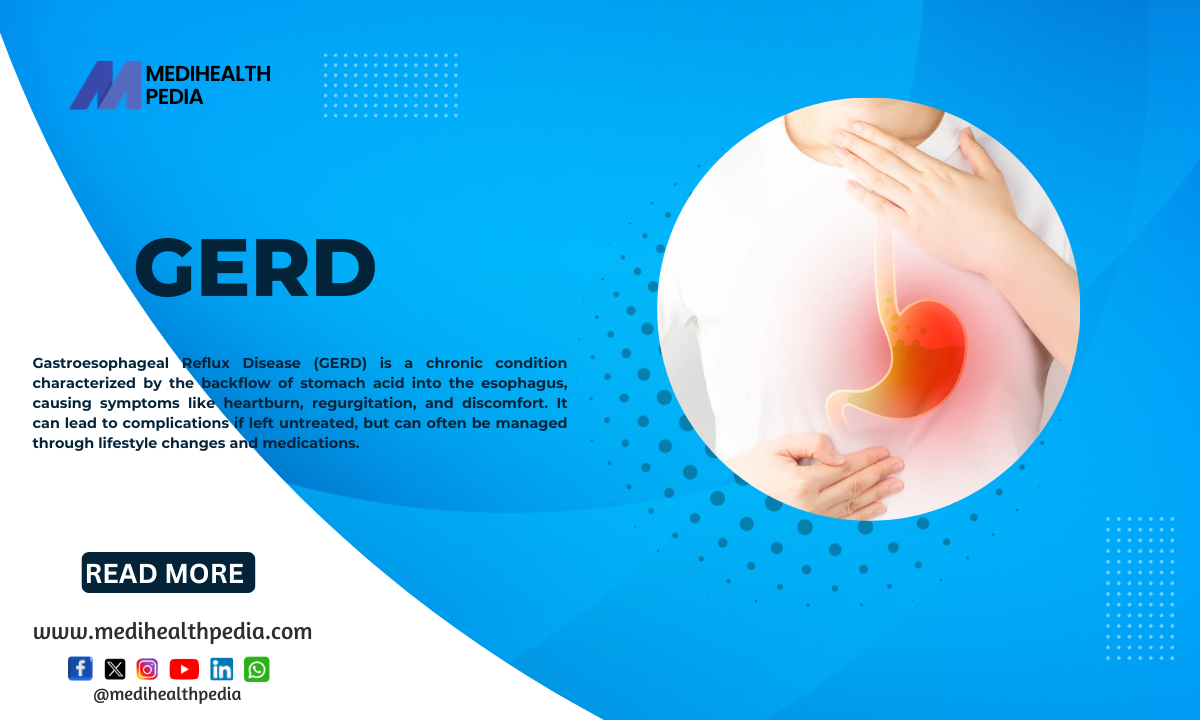Gastroesophageal Reflux Disease (GERD): An In-Depth Guide
Introduction
Gastroesophageal Reflux Disease (GERD) is a chronic medical condition that affects millions of people worldwide. Characterized by the backward flow of stomach acid into the esophagus, GERD can lead to a range of uncomfortable and potentially serious symptoms. In this comprehensive guide, we will explore GERD in detail, including practice essentials, clinical presentation, differential diagnosis, workup, conventional treatment, prevention, herbal medicines, lifestyle modifications, and conclude with insights on living with this condition.

Practice Essentials of GERD
Understanding the fundamental aspects of GERD is crucial for both healthcare professionals and patients alike. Let’s delve into the essentials of this condition.
- Anatomy and Physiology
GERD is primarily related to the lower esophageal sphincter (LES), a circular band of muscle at the junction of the esophagus and stomach. Its role is to prevent the backflow of stomach contents into the esophagus. When the LES becomes weak or relaxes inappropriately, stomach acid can flow backward, leading to the development of GERD.
- Epidemiology
GERD is a common condition that affects people of all ages. Approximately 20% of the U.S. population experiences symptoms of GERD at least once a week, and about 7% experience daily symptoms. It is more prevalent in adults, but children and adolescents can also be affected.
- Risk Factors
Several factors can increase the risk of developing GERD, including obesity, hiatal hernia, pregnancy, smoking, and certain medications. Lifestyle factors, such as a high-fat diet, heavy alcohol consumption, and late-night eating, can also contribute to the condition.
Clinical Presentation of GERD
GERD manifests with a variety of symptoms, which can range from mild discomfort to severe distress. The presentation can vary among individuals, and some of the common symptoms include:
- Heartburn
Heartburn is the hallmark symptom of GERD. It is described as a burning sensation in the chest, often behind the breastbone, that may radiate to the neck and throat. It typically occurs after meals and when lying down.
- Regurgitation
Regurgitation is the involuntary flow of stomach contents into the mouth. This can lead to a sour or bitter taste, and individuals may spit up small amounts of stomach acid.
- Dysphagia
Difficulty swallowing, or dysphagia, can occur when the esophagus becomes inflamed or when stricture (narrowing) develops due to chronic acid exposure.
- Chest Pain
Chest pain can mimic cardiac-related symptoms. It is important to differentiate between GERD-related chest pain and heart-related chest pain, which can be life-threatening.
- Chronic Cough
GERD can trigger a persistent, dry cough, often worse at night or in the early morning.
- Laryngitis and Hoarseness
Chronic acid exposure can irritate the vocal cords, leading to laryngitis and hoarseness.
- Asthma and Respiratory Issues
Some individuals with GERD experience worsened asthma symptoms or recurrent respiratory issues, such as wheezing or bronchitis.
- Dental Problems
The frequent exposure to stomach acid can lead to dental problems, including tooth erosion.
It’s important to note that GERD symptoms can be more severe at night, leading to sleep disturbances and reduced quality of life.
Differential Diagnosis
Given the wide array of symptoms associated with GERD, it’s essential to consider other conditions that can mimic its presentation. Some conditions that may be confused with GERD include:
- Peptic Ulcer Disease
Peptic ulcers can cause burning abdominal pain that may be mistaken for heartburn. It’s important to differentiate these conditions to provide appropriate treatment.
- Gallbladder Disease
Gallbladder disease, such as gallstones, can lead to abdominal pain and discomfort, which can radiate to the chest and mimic GERD symptoms.
- Esophageal Motility Disorders
Certain esophageal motility disorders, such as achalasia, can cause symptoms similar to those of GERD, including difficulty swallowing and regurgitation.
- Cardiac Conditions
Cardiac conditions, including angina and heart attack, can present with chest pain that resembles heartburn. Accurate diagnosis is crucial to avoid life-threatening consequences.
- Functional Gastrointestinal Disorders
Conditions like functional dyspepsia or irritable bowel syndrome can manifest with symptoms that overlap with GERD, such as abdominal discomfort and indigestion.
To distinguish GERD from these conditions, healthcare professionals rely on a combination of clinical evaluation, diagnostic tests, and patient history.
Workup for GERD
Diagnosing GERD typically involves a stepwise approach that may include the following:
- Clinical Evaluation
A comprehensive history and physical examination help in understanding the patient’s symptoms and their impact on daily life.
- Symptom Assessment
The healthcare provider assesses the frequency and severity of GERD symptoms, their timing, and any exacerbating or relieving factors.
- Lifestyle and Dietary Assessment
Patients are often asked about their dietary habits, lifestyle factors, and medications they may be taking, as these can contribute to GERD.
- Endoscopy
Upper endoscopy involves the insertion of a thin, flexible tube with a camera (endoscope) into the esophagus. It allows for the direct visualization of the esophagus, stomach, and part of the small intestine. This helps identify inflammation, strictures, or other abnormalities.
- Esophageal pH Monitoring
Esophageal pH monitoring measures acid exposure in the esophagus over a specific time period. It can help confirm the presence of abnormal acid reflux.
- Barium Swallow
Barium swallow involves drinking a contrast material that allows visualization of the esophagus and stomach on X-ray images. It can identify structural abnormalities.
- Manometry
Esophageal manometry measures the pressure and muscle contractions in the esophagus. It is used to evaluate esophageal motility and identify conditions like achalasia.
- Ambulatory pH Monitoring
Ambulatory pH monitoring involves a small device worn by the patient that continuously measures acid exposure in the esophagus over 24-48 hours. This test is particularly useful for detecting acid reflux episodes that occur outside of traditional meal times.
The combination of these diagnostic tools allows healthcare professionals to make an accurate diagnosis of GERD and tailor treatment plans to each patient’s specific needs.
Conventional Treatment for GERD
The management of GERD primarily aims to alleviate symptoms, prevent complications, and improve the patient’s quality of life. Common conventional treatments include:
- Lifestyle Modifications
- Dietary Changes: Avoid trigger foods and beverages such as caffeine, alcohol, citrus, tomatoes, and spicy or fatty foods.
- Weight Management: Achieving and maintaining a healthy weight can reduce pressure on the LES.
- Elevating the Head of the Bed: Elevating the head of the bed by 6-8 inches can help prevent nighttime acid reflux.
- Medications
- Antacids: Over-the-counter antacids like Tums or Rolaids can provide short-term relief by neutralizing stomach acid.
- H2 Blockers: Histamine H2 receptor antagonists, like ranitidine (Zantac) or famotidine (Pepcid), reduce acid production.
- Proton Pump Inhibitors (PPIs): Medications like omeprazole (Prilosec) or esomeprazole (Nexium) are more potent at suppressing acid production and are often prescribed for moderate to severe GERD.
- Prokinetics: Prokinetic medications help strengthen the LES and promote more coordinated esophageal contractions.
- Endoscopic Treatments
- Endoscopic Procedures: Techniques like Stretta and EndoCinch use an endoscope to modify the LES and prevent acid reflux.
- Surgical Interventions
- Fundoplication: Fundoplication surgery wraps the top of the stomach around the lower esophagus to strengthen the LES and prevent reflux.
It’s crucial for healthcare providers to tailor treatment plans to the severity of the patient’s condition. While lifestyle modifications and medications are often effective, surgical or endoscopic interventions may be considered for individuals with severe or refractory GERD.
Prevention of GERD
Preventing GERD or reducing its severity involves a combination of lifestyle changes and avoiding triggers:
- Dietary Modifications
- Avoid trigger foods and beverages, as mentioned earlier.
- Practice mindful eating by chewing slowly and consuming smaller, more frequent meals.
- Weight Management
- Maintain a healthy weight and avoid excessive abdominal fat, which can put pressure on the LES.
- Lifestyle Changes
- Elevate the head of the bed if nighttime symptoms are problematic.
- Avoid lying down for at least three hours after eating.
- Quit smoking, as it can relax the LES.
- Medication Management
- Take prescribed medications as directed by your healthcare provider.
Herbal Medicines for GERD
Complementary and alternative therapies, including herbal remedies, are sometimes sought by individuals looking for additional relief. It’s essential to approach herbal treatments with caution and consult with a healthcare provider before use, as their effectiveness can vary between individuals. Some herbs and remedies that have been explored for GERD include:
- Aloe Vera
Aloe vera juice can help soothe the esophagus and reduce inflammation. It is best consumed in moderation, as excessive use can have laxative effects.
- Ginger
Ginger has anti-inflammatory properties and can be brewed into a tea to ease digestion and reduce heartburn symptoms.
- Slippery Elm
Slippery elm has been used for centuries to treat various gastrointestinal ailments. It forms a gel-like substance when mixed with water, which can help coat and soothe the esophagus.
- Marshmallow Root
Marshmallow root, similar to slippery elm, creates a soothing, protective layer in the esophagus, reducing irritation from acid reflux.
- DGL Licorice
Deglycyrrhizinated licorice (DGL) has been studied for its potential to relieve heartburn and protect the esophageal lining.
Always consult with a healthcare provider before using herbal remedies, especially if you have existing medical conditions, are pregnant, or are taking other medications.
Lifestyle Modification for GERD
GERD is a common and often chronic condition that can significantly impact an individual’s quality of life. While it can be effectively managed with lifestyle modifications and medications, it is important to work closely with healthcare providers to develop a personalized treatment plan.
Complementary therapies, such as herbal remedies, can offer additional relief for some individuals, but their efficacy can vary. Always consult with a healthcare provider before using herbal treatments.
In conclusion, living with GERD requires diligence in symptom management, dietary choices, and lifestyle modifications. By understanding the condition and working with healthcare providers, individuals with GERD can lead fulfilling lives while effectively managing their symptoms. Remember that early diagnosis and appropriate management are key to preventing complications and ensuring a better quality of life.
Conclusion
GERD is a common and often chronic condition that can significantly impact an individual’s quality of life. While it can be effectively managed with lifestyle modifications and medications, it is important to work closely with healthcare providers to develop a personalized treatment plan.
Complementary therapies, such as herbal remedies, can offer additional relief for some individuals, but their efficacy can vary. Always consult with a healthcare provider before using herbal treatments.
In conclusion, living with GERD requires diligence in symptom management, dietary choices, and lifestyle modifications. By understanding the condition and working with healthcare providers, individuals with GERD can lead fulfilling lives while effectively managing their symptoms. Remember that early diagnosis and appropriate management are key to preventing complications and ensuring a better quality of life.

